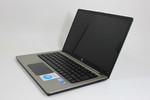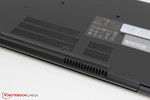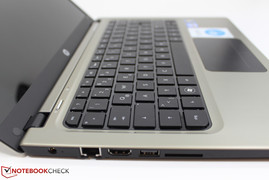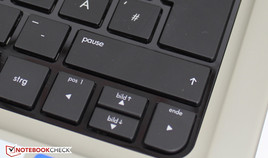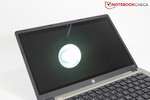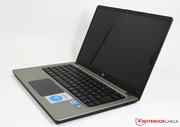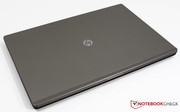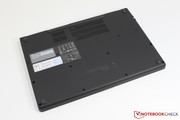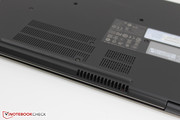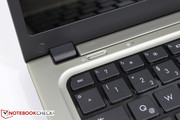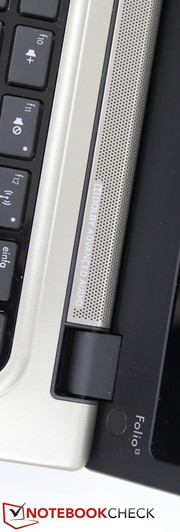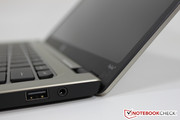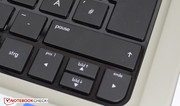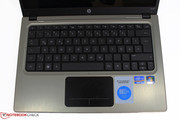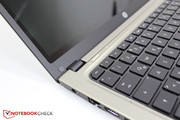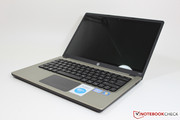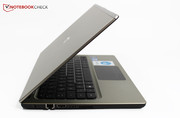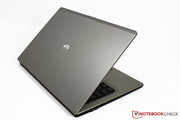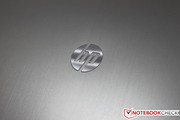Review HP Folio 13-2000 Ultrabook
In an inconspicuous box, as we've come to expect from HP, the object of desire hides away. "The computer is personal again", promises the well-known manufacturer's slogan.
The box is massive compared to the notebook itself, leaving a lot of space on the inside. The only accessory is the small, light power supply alongside a few HP brochures. The first sensational aha moment comes when we try to take the Folio out of the packaging. When picking it up you won't at all be prepared for the sheer thinness of the device, leaving you fumbling around in nothingness for a while before you finally grasp the 'hipflask'.
The second aha moment comes not a moment later, when our eyes become fixed by the thinness of the notebook, allowing us to visually take in the device. This moment comes with the realization that HP has done real justice to its own design ethos. Here, nothing is belied.
The height of the actual case (when closed) is, after double-checking, 1.5 cm - which is consistent. If you count the rubber feet, the Folio reaches a height of just 2 cm. At first you might be baffled, and soon you find yourself picking up the device again and looking over the edges from the side, checking how flat the device is.
Case
At HP they really must have thought: "How thin shall we make our Ultrabook? Only so thin that we don't have to leave out our fattest connection, the LAN port...". No sooner said than done! The design is very likeable, as is the 1470 gram weight, which amounts to very little indeed.
The build quality and the feel of the materials are two things that also turn out positively. No creaks, no cracks and no squeaks - even during an intensive pressure test. The rigidity is also surprisingly high for the thin lid, not least due to the solid materials. For example, brushed aluminium is used for the surfaces, and velvety matte processed plastic, very pleasant to the touch, is used for the display edges and the surfaces on the underside of the case. The angular design isn't overdone (for example the case with Apple), as the edges and corners are harmoniously and ergonomically rounded off. On the lid, as we've seen on the Probooks from HP, there's a slightly coloured, thin handle strip for opening the lid, which is alongside the metal, shiny HP emblem in the middle. Indeed HP doesn't always use metallic surfaces in contrast to so many well-known competitors, nevertheless it at least looks as valuable as its rivals.
What we really liked at first was the fact that the designers have also kept some things in mind when it comes to the little details. The vents for the fans are only put where you're least likely to cover when using the device on your lap, which shouldn't be a rare occurrence considering it's a mobile device. Thus the slats are placed in the middle towards the back of the underside, in order to allow a constant flow of air.
Now it's time to open the hatch. Thankfully the screws aren't too stiff but are firm enough to prevent the display from teetering or inadvertently changing the viewing angle. Before we address the input devices, let's look at the connectivity of the Ultrabook. All in all a sleek first impression.
Connectivity
What HP includes on the device for the purpose of connectivity is pretty much standard fare in the notebook domain. Everything important is present, if not in excessive numbers.
To transfer display contents, HP only provides an HDMI port. This might leave a sour taste in the mouths of some potential customers that would like to use the Ultrabook for presentations, and thus would require the most common interface for most current projectors, namely VGA, which is nowhere to be found. So in this case it's worth being on the safe side and checking whether the projector in question supports HDMI, yet this won't leave the user feeling too confident on business trips without their own projector. If you're after home-entertainment, you'll only be happy with HDMI anyway.
Peripherals like external hard disks, mice or keyboards are served by USB on the Folio. Admittedly there are only 2 USB ports, one of which (on the left side of the case) is a fast USB 3.0 variant, whilst the other on the right side is a conventional USB 2.0 port. This left- right- separation is on the one hand good, as wide USB sticks don't get in each other's way, yet on the other hand it could become problematic when USB hard disks or other external drives are used that need two adjacent USB ports due to having a USB-Y cable to receive enough energy from the ports.
To get photos and videos from your camera, you can either use the USB connection or the card reader (SD / MMC). On the right-hand side of the case there's also a combined headphone-out/microphone-in next to the USB 2.0 port. Video conferencing is taken care of by the 1.3 megapixel webcam with a good image quality, whilst sound is recorded by a small microphone which is found on the far left in the recess that surrounds the keyboard, alongside the shift key. The microphone has a consistently acceptable quality, but this isn't the case when you type on the keyboard during calls, as the noise is extremely disturbing and too loud, and so is heard in the conversation.
Communication
Networking on the HP Folio 13 is supplied by both the LAN adaptor (Realtek PCIE GBE Family Controller, 10/100/1000 MBit) and the WLAN adaptor (Intel Centrino Wireless-N 1030). For wireless connections to various headsets, smartphones or the like, there's also Bluetooth 3.0 on board the WLAN adaptor.
Maintenance
On the matte black underside of the Folio there is basically no maintenance hatch, yet some Phillips screwdrivers leave us hoping that the Folio, like for example the Macbook, can be opened. So, after all screws were removed, the first careful attempts were undertaken to free the case from the plastic underside, at first in vain. The clips on the case are too tight. Finally we managed to find an easy entry-point in the corner of the slot of the power supply, and bit by bit we removed the shell.
The components are at times on the base and sometimes on the shell and only connected by thin cables, which means that opening the case without separating the keyboard and touchpad from the case, for example, isn't possible. Looking through the very narrow opening reveals that in fact opening the folio wouldn't make sense anyway, as almost everything is soldered onto the mainboard, and a special tool is needed for the thin cable plug. In order to spare your nerves, the warranty and the Folio itself, it's advised not to open the Folio.
Accessories
Accessories are extremely thin on the ground. Alongside the notebook there's only the power supply in the box and a quick-start guide from HP, which, at three pages of duplex paper, only seems to want to explain booting up the system and the settings that need to be sorted at the beginning. As we have come to expect from HP, this process really gets on the users' nerves, as setting up the system and the first boot-up are much easier on other manufacturers' devices - the supplied HP programs even pop up in later use with considerable obtrusiveness (for example through update notifications and the like) and even caused some of our benchmarks to be aborted. Such bloatware begs to be deactivated or completely uninstalled.
Warranty
HP grants the Folio a 12-month warranty, which lags behind the competition.
Input Devices
Keyboard
Here too we find the well-known HP design with rounded-off corners. Inset in the aluminium surface, the velvety matte-black keyboard lies in a glossy, black recess with the keys in the chiclet style, which is almost standard nowadays.
On first glance the keyboard commits no kind of faux pas, but from looks alone we can't rightly judge a keyboard, so we got hands-on. Our hands have rarely touched such a perfectly crafted keyboard on any other notebook. The heels of the hand always rest comfortably on the aluminium palm rests; no sharp edges disturb this peace. The texture and feel of the keys are honestly comparable to the Macbook - very velvety. Just like the expensive competition from Cupertino, the keys have white back-lights, yet brightness isn't automatically adjusted according to the environment like it is on the Macbook Pros, so you can only turn the back-lights on or off, yet the real purpose of such a feature is questionable anyway.
Typing is also convincing. A very crisp pressure point and a short stroke make typing on the notebook very pleasant and problem-free. Typos are rare and the layout is great. Critics might complain that the Folio 13's cursor keys (up and down) are shrunk to half-size to fit better under the left shift key (which is full size!). The fact that the row of function keys (rather rare on Microsoft devices) only activate special functions (volume, display brightness, ...) out of the box and not F1-F12 implies very precisely which competitor has been observed more closely. This setting might at first be annoying, as usual shortcuts like Alt+F4 for closing a program can only be performed when pressing the Fn-key too, yet this functionality can be reverted via a simple setting in the BIOS.
Touchpad
The black glass surface stretches just short of the lower edge of the case, almost leaving you asking yourself where the click buttons are hidden. You finally notice the markings on the lower area of the touchpad and you try them out. They're more difficult to use than we would have thought - okay, maybe the buttons are capacitive - maybe not... hm... let's press harder - ah, I can feel it coming - even harder - finally, I can click!
You really don't want to be straining so much to click. Our suggestion: use the tap-to-click gesture. Indeed this only helps when left-clicking - if you want to reach the context menu, you have to resort back to the stiff right-key. After a while you will probably get used to the touchpad keys being like this, but then when using other notebooks you have to be careful that you don't use the same amount of pressure so as not to break the key or your thumb joint. Apart from this problem the touchpad performs well, is precise and can be navigated problem-free around the screen, whilst multi-touch gestures like two-finger scrolling or pinch-to-zoom gestures, amongst others, are supported.
Display
The reflective 13.3-inch TN panel from LG is no exceptional performer. When turned off, the large glossy surface that also stretches beyond the webcam hints at an edge-to-edge display. When the notebook is turned on, however, you see the black border around the monitor. On an Ultrabook, where portability and mobility come first and foremost, the manufacturer's greatest priority shouldn't be the cheapest price but instead its capability outdoors. In other words: can you still see the display contents on the go in a range of lighting conditions? If a reflective display is used, at least it should be supported by powerful background illumination to outshine reflections in bright conditions.
The brightness of the Folio 13's display isn't so convincing. The maximum brightness running on the mains is a weak 180 cd/m². This might be enough for indoor use, and doesn't pose any problems to the user, but the situation changes when you venture outdoors.
| |||||||||||||||||||||||||
Brightness Distribution: 87 %
Center on Battery: 176.4 cd/m²
Contrast: 147:1 (Black: 1.2 cd/m²)
39.02% AdobeRGB 1998 (Argyll 3D)
56.9% sRGB (Argyll 3D)
37.77% Display P3 (Argyll 3D)
If you plan on using your Ultrabook mostly indoors and never under direct sunlight, this display proves to be adequate. The horizontal viewing angles are extremely high and at almost 170° with very few colour distortions, meaning a large audience can easily be shown your newest holiday photos on the sofa. The vertical viewing angles are only average, yet by changing the opening angle of the lid (which is thankfully rather generous, but not world-changing) you can counteract the otherwise rather fast-appearing bleaching effect.
When editing images you shouldn't bank on the colour rendering of the panel, which doesn't even cover the sRGB colour spectrum. Professionals will anyhow work on other devices or connect good external monitors. The average office/multimedia user will remain unfazed by the colour spectrum available. The subjective impression we get from the display's colour display is okay. There are worse panels but there are much better panels too, yet many relevant competitors have to tackle the same problem here with the display.
Performance
With the Folio 13 you've always got a very fast device at your fingertips. Sure, the 128GB SSD from Samsung performs well, the load times are short, as well as booting the system up and starting programs, or quickly browsing photos (where conventional hard disks often surrender to long loading times). When you work wirelessly, too, the performance in energy-saving mode is impressively fast. You can easily watch HD YouTube videos on the go without fear that you'll embarrass yourself with a flip-book. Of course, you won't really be editing HD videos on the Folio, even if it's theoretically possible - there are dedicated devices for that.
As for games, the Folio is a little off-colour - mainly because the graphics chip HD 3000 in the Intel Core i5 2467, which is otherwise suited to games only to a limited extent, is underclocked by around 300 MHz due to the energy-saving preference. But hey, in doing so the battery life is kept in check without having to do without treats such as surfing or multimedia on the go. Now let's take a closer look at the detailed results of the device's components.
Processor
As is mostly the case on Ultrabooks or generally on devices designed for mobility where a bit more performance is sought, an Intel ULV (Ultra Low Voltage) processor comes into play. The Core i5 2467M in the Folio 13 is characterized by its focus on energy saving, standard speed (1.6 GHz – 2.3 GHz) with just 17 Watt TDP (Thermal Design Power) putting together an attractive total package for long continuous computing marathons, or when the Ultrabook isn't heavily challenged (internet, word processing,...) the computing power is automatically decreased in order to save the battery. The current 28 nm process of the Sandy Bridge generation from Intel adds the best possible economizing and also limits heat waste produced, which the Folio 13 does well with overall, but more on that below in the review. The dual-core processor supports Hyper-Threading, which means that each core can simultaneously execute two threads, which leads Windows to show four cores in Task Manager, instead of two on AMD dual-core processors, for example.
The Folio 13 completes Cinebench R11 around 18% slower than the frontrunner (Macbook Air 11"), but is still somewhat faster than, for example, Acer's Aspire S3. On the older Cinebench R10, however, the Folio renders just as quickly as the fastest of the Ultrabooks, and even leaves the Air behind it by a small margin (see below). All in all the ULV processor performs comparatively as fast as current Core i3 processors (e.g. 2330M).
System Performance
Here, PCMark Vantage gives us a good insight into the overall performance of a notebook. Videos are played, photos are edited and different websites are surfed, amongst other things, either sequentially or simultaneously, to simulate the "real life" of a notebook. The Folio 13 secures a very good result in the rankings.
The identically-equipped competition from Apple, Asus and Co. is beaten by the Folio 13 by around 20% in the overall score of PCMark 7, in PCMark Vantage it's mid-table (Air 11" around 9% better, U300s around 8% worse).
Special thanks must go to the fast mass storage, which, due to Solid State technology, reads and writes data a great deal faster than many conventional magnet disk drives with higher capacity, which are for example present on some gaming notebooks.
As a result it comes as no surprise that in the overall score, its direct neighbours are home to much faster CPUs and yet have only approximately similar results. The result of the PCMark benchmark confirms the fast impression that the Folio gave us in the test.
| PCMark Vantage Result | 8707 points | |
| PCMark 7 Score | 2953 points | |
Help | ||
The Wprime 32M benchmark reveals (for now) a surprisingly weak result for the Folio 13 compared with the Ultrabook competitors Macbook Air 11" and the Asus Zenbook UX21E (in each case exactly the same processor). Both obtain a score that's around 25% better and are finished with the computational tasks earlier than the Folio. This made us a little suspicious. With the same processor there are such differences? This called for a repeat of the tests. This time the Folio managed the best performance of the three contestants by a whisker.
In search of the cause of the differences in the test results we finally sussed out the problem: on the first run the notebook was on the table, on the second it was on the reviewer's lap. We tested it again on the table - and once again, performance decreased in the benchmark by around 20%. Therefore we've found a pattern: on the table the fan is much louder, only moments later to become quieter. The notebook starts out with usual full performance at first, yet the cooling obviously doesn't suck in enough fresh air. As the fan openings are possibly too close to the table, the fan spins as much as it can (which admittedly isn't very loud, but more on that later) and surrenders violently again amidst rising temperatures with a decrease of Turbo Boost from 2.3 GHz to 2.1 GHz. Then, however, the fan decelerates, so that the Folio works quieter on the table under full load. If the Folio has enough air, the Turbo Boost remains at the usual speed during the WPrime test.
On the one hand this shows that this was intentional to keep system noise to a minimum, and this really does make sense for Ultrabooks. Target users are more likely to complain about the fan being too loud than slightly slower performance. Yet this barely detracts from the thought that this is a questionable compromise, as the competition also gets the sought-after results with their devices on the table. So if you're editing a holiday video and you want to render it, you should either put the notebook on your lap or be careful that you give the fan openings enough room to breathe – in the WPrime test a wallet was used to raise the notebook up.
Warning: all test results (apart from the aforementioned WPrime tests) were measured in 'table mode' and so on the CPU side of things performance could be 20%-30% better, if you let the notebook breathe.
Mass storage
The HP Folio 13 splashes out on mass storage from Samsung in the form of a 128GB SSD drive. Indeed this drive is by no means the fastest amongst the solid-state-drives, but with 4K write speeds of 38.35 MB/s and read speeds of 13.23 MB/s it ensures a noticeable speed boost over conventional hard disks, even if it can only read or write data half as quickly as frontrunners of the range (e.g. OCZ Vertex 3, Intel 510).
Graphics solution
The graphics solution which is integrated into the processor (Intel HD 3000) has a clock speed in the Core i5 2467M that's 300 MHz slower than normal, but performs well in general multimedia use. For example, all kinds of HD video material run judder-free (for watching on the flat-screen at home). The graphics aren't geared towards gaming, however, and in the well-known 3DMark 06 test (keep in mind the aforementioned ventilation problems) the Folio again lines up a considerable (23 %) distance behind the best, identically-equipped competitor (here the Macbook Air 11"), and also comes in last place amongst all tested identically-equipped Ultrabooks.
| 3DMark 06 Standard Score | 3083 points | |
Help | ||
Gaming Performance
Now and then the odd game to relax should be possible on the Folio, even if on low settings. Anno 2070, the newest offspring of the cult city-building strategy series, was used to test gaming performance. Thanks to the good scalability of both the graphics- and performance-requirements, Anno 2070 offers the Folio the perfect opportunity to find the hardware's limits. At a resolution of 1024x768 and low settings, the game mostly stays judder-free and plays at a rate of between 24-34 frames per second, yet whilst it might look respectable, it does look pixelated. At medium quality with anti-aliasing and at the native resolution of the Ultrabook at 1366x768, the frame rates fall dramatically. These range from 23 (image of the open sea) down to 10 frames per second (image of the hustle and bustle of the city). Consequently it becomes similar to the flicker books of old, even if it's not as off-putting as in other games. At most you only notice the juddering when the display detail is moved.
Recommendation: turn off anti-aliasing. Nevertheless: anything more than medium details is too much for the device.
| low | med. | high | ultra | |
|---|---|---|---|---|
| Anno 2070 (2011) | 30.7 | 15.1 |
Emissions
System Noise
Straight out of the box the Folio is constantly noticeable. This isn't a result of the system noise (on average 36 dB under load, or just 28-32 dB when idle, which would be good values) but rather due to the high frequency sound of the fan noise, which is likely to get on a few users' nerves.
Nevertheless, there's a setting in the BIOS (reachable by pressing F10 at start-up) that allows you to deactivate "fan always on", and it's not quite clear why this isn't deactivated out-of-the-box. In this way the Folio is almost consistently quiet, the fan only occasionally and briefly announcing itself to dissipate heat, or a bit longer when a video's being watched, only subsequently to become quiet again. Most of the time, during simple tasks like surfing, the Folio remains completely silent as no hard disk is spinning - thanks to the SSD. Why, HP, is this not the case straight away?
Noise level
| Idle |
| 28.6 / 31.8 / 31.8 dB(A) |
| HDD |
| 31.8 dB(A) |
| Load |
| 36.4 / 43.5 dB(A) |
 | ||
30 dB silent 40 dB(A) audible 50 dB(A) loud |
||
min: | ||
Temperature
During normal use, so low load, the Folio always remains pleasantly cool. On the upper side the highest temperature is 28.7 °C, on the underside 30.5 °C –just enough to defrost ice-cold hands.
By contrast, after a while of full load via Prime95 and the simultaneous running of Furmark (which in fact is a load that would never really be reached on an Ultrabook in practice), the upper side in the central and left, upper keyboard area become very warm (temperatures at an average of 40 °C).
At first, Turbo Boost was only slightly activated, and on the processor (1700 MHz, Standard: 1600 MHz) as well as the graphics processor (950 MHz, Standard: 350 MHz) the core temperatures were around 70 °C. After an hour of load the temperature was at 86 °C. The processor is certified by Intel up to 100 °C, so these are in no way troublesome values, however the cooler the hardware stays under load, the more the Turbo Boost feature can automatically overclock the CPU. Certainly very few people would ever load their processor and graphics card 100% for such a long time, and only sometimes peaks in computational power are required, with the result that, on the Folio 13, you'll very often take advantage of Turbo Boost, as well as a cool device.
(±) The maximum temperature on the upper side is 43.9 °C / 111 F, compared to the average of 35.9 °C / 97 F, ranging from 21.4 to 59 °C for the class Subnotebook.
(-) The bottom heats up to a maximum of 52.8 °C / 127 F, compared to the average of 39.3 °C / 103 F
(+) In idle usage, the average temperature for the upper side is 26.8 °C / 80 F, compared to the device average of 30.8 °C / 87 F.
(+) The palmrests and touchpad are cooler than skin temperature with a maximum of 29.6 °C / 85.3 F and are therefore cool to the touch.
(±) The average temperature of the palmrest area of similar devices was 28.2 °C / 82.8 F (-1.4 °C / -2.5 F).
Speakers
In light of the small measurements of the device, what you get from the Dolby-certified speaker bar is thoroughly convincing, even at a moderate volume. High tones and middle tones are very clear and defined, whilst the bass notes are, as expected, only very weakly present, if at all. We can't hold this against the Folio 13, however, as the playback of speech is excellent. There were no cases of overdrive in the review, even no cracking - very good indeed. Also impressive is the maximum volume. It's easily enough to fill a mid-sized room for a presentation with sound, yet the quality of sound does become rather hissy, as the high notes seem too pronounced. What amounts to 60% of the maximum volume on the Folio is, by comparison, the maximum volume on a Macbook Pro 15", and so the speaker sound of the HP device seems somewhat richer, if somewhat slushier, than that of the professional device with an Apple sticker, which is also often used by DJs as a workhorse.
With good headphones the Folio performs well, as basses are played back very well. Portable notebooks should sound like this, not like anything else!
Battery Life
Arguably the most important factor when reviewing an Ultrabook - how long can it hold out for?
The 59 Wh battery in the Folio scores good results thanks to the economical hardware. The minimum power consumption is 5.6 Watt (idling, maximum energy-saving settings), maximum 35.8 Watt (under full load). The - purely subjectively - most telling test, the practical battery life test, is where "general" usage is simulated, and so, for example, the web is surfed, YouTube videos are watched and some word processing is done (the review was written on the Folio itself). Here an overall running time of 6 hours and 17 minutes was reached. The device had previously been set to energy-saving mode and the brightness was set to around 50%, likewise the backlit keyboard was activated, whilst WLAN was of course activated in order to surf the web.
What the Folio emphasises when it comes to its energy efficiency is the great result from the low load test. The battery held out for 9 hours and 49 minutes on the Battery Eater Reader's benchmark with deactivated WLAN, activated energy-saving mode and the lowest display brightness setting. This simulates, for example, reading eBooks or text-based similar tasks that don't require an internet connection. Its well-known competition can, for the most part, only reach around seven hours. Under full load (simulated by the Battery Eater Classic benchmark with activated WLAN and maximum brightness) HP's first Ultrabook hangs on for around 2 hours and 50 minutes until it fell into a deep sleep.
| Off / Standby | |
| Idle | |
| Load |
|
Key:
min: | |
Verdict
Even amongst Ultrabooks this device has an exceptional battery life, a stable and very sublime case, surfaces that feel velvety, soft and just great, the backlit keyboard and (if on the right setting) the very moderate, often not even present background noise, which should all definitely help establish a purchase recommendation for the Folio 13 at the target price of just under €1000.
For buyers that mainly work in buildings or darker environments, or don't necessarily need a VGA connection, and can only connect monitors via HDMI anyway, the HP Folio 13 is certainly interesting.
Unfortunately it doesn't constitute a "no brainer purchase" and we can't recommend it without reservations, as a display that can be used outdoors is almost the most important criterion for mobile use, and due to the glossy, not overly bright display, it simply can't hold a candle to the competition, for example the UX31 from Asus, even if it brings with it good viewing angle stability.
So if you can live with the glossy display, the stiff touchpad keys and also the quiet but high frequency fan noise, even if it blows waste heat away from the device, you get a nicely designed, portable entertainment-, internet- and works-notebook, which comfortably brings along with it a full workday away from the power supply.
On the whole HP has shown that even as one of the last through the door to the Ultrabook party, it can offer a really attractively developed device compared to the competition, even if it forewent the Ultrabook crown due to the odd shortcoming.






